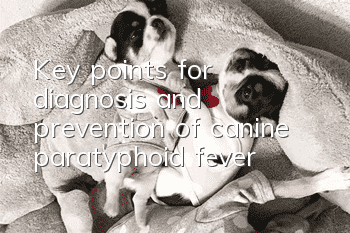Key points for diagnosis and prevention of canine paratyphoid fever

Key points for diagnosis of canine paratyphoid fever:
1. Clinical symptoms include sudden acute gastroenteritis in sick dogs, with high fever, anorexia, vomiting and diarrhea. , the feces is watery and mucus-like, and in severe cases, bloody stools may be passed. His body rapidly collapsed, his mucous membranes became pale, and he eventually died of dehydration and shock. In addition, bacteremia and endotoxemia are prone to occur in puppies, manifested by lowered body temperature, general weakness and poor capillary filling.
2. Pass laboratory inspection. Many diseases can cause high fever, anorexia, vomiting and diarrhea in dogs. It is also common for even healthy livestock and poultry to be infected with Salmonella. If you want to confirm the diagnosis, you need to collect the spleen, mesenteric lymph nodes, The liver, bile and other sick materials are sent for bacteriological examination. Only when pathogenic Salmonella is found in the sick materials can the diagnosis of canine paratyphoid fever be confirmed.
Prevention and treatment measures for canine paratyphoid fever:
1. It is strictly forbidden to feed meat from dead animals. It is best to cook the meat before feeding it to dogs.
2. Clean and disinfect the dog’s utensils frequently, and pay attention to killing rats and flies.
3. If a sick dog is found, isolate it for treatment in time. It is best to send a dedicated person to manage it. It is strictly forbidden for sick dogs to come into contact with healthy dogs. Disinfect kennels, places where sick dogs pass by, and food utensils. You can use 2% to 3% caustic soda solution, bleaching powder emulsion, 5% ammonia, etc.
4. Once a dog dies, the body must be buried deeply to prevent cross-infection.
Treatment methods for canine paratyphoid fever:
1. Chloramphenicol is 15 to 50 mg per kilogram of dog weight, 2 to 4 times a day, and used for 4 to For 6 days, the intramuscular dose is halved.
2. Furazole is 2 to 6 mg per kilogram of the dog's body weight, taken orally in 2 times, and used continuously for 5 to 7 days.
3. Sulfamethoxazole is 0.02~0.05 grams per kilogram of dog weight, taken orally twice a day for 7 days.
4. Garlic can be taken orally, that is, take 5 to 25 grams of garlic and pound it into minced garlic and take it orally, or make a garlic tincture and take it orally, 3 times a day for 3 to 4 days.
5. Infusion is used to assist treatment and provide symptomatic treatment, such as maintaining heart function, clearing intestines and fermenting, and protecting gastrointestinal mucosa.
- What to do if Teddy has tear stains? Causes and treatment methods for Teddy to have tear stains!
- What are the key points for raising golden retrievers?
- Common signs of heart disease in dogs
- How do owners perform physical examinations on pets (Part 2)
- What to do if your dog has rheumatic pain
- What medicine can be used to treat skinny dogs?
- Puppies should not drink milk
- Why do dogs get uremia?
- What are the symptoms of low-grade fever in dogs?
- Do dogs need rabies vaccinations every year?



